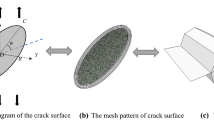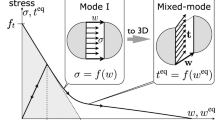Abstract
This paper contains the second part of our work on tensile cracking that has been conducted over the past years. The behavioural of concrete and sandstone subjected to uniaxial tension is decribed. In part 1 of this paper [1], a numerical lattice model is presented, which is used for explaing fracture mechanisms in heterogenous materials like concrete and sandstone. In the lattice model, the material is schemitzed as a lattice of brittle, breaking beam elements. Cracking is simulated by removing, in each step, the element with the highest stress—to—strength ratio. It was shown that the amount of detail included in the numerical model has a significant effect on the ductility in the load-displacement diagram. In this paper, special attention is given to the effect of varying the rotational stiffiness of the loading platens in uniaxial tensile tests. Experiments are presented of cylindrical specimens of various sizes loaded in tension between non-rotating (fixed) and freely-rotating boundaries. The lattice model is used for a qualitative analysis of the subject. The results suggest that the uniaxial tensile test between freely rotating boudaries yields a (safe?) lower bound for the fracture energy of concrete.
Résumé
Cet article présente la seconde partie des trauvaux que nous avons effectués ces dernières années sur la fissuration en traction. On y décrit le comportement du béton et du grès soumis à une traction uniaxiale. Dans la première partie [1], nous avons présenté un modèle numérique réticulaire permettant d'analyser les mćanismes de rupture dans des matériaux hétérogènes comme le béton et le grès. Dans ce modèle, le matériau a été figuré comme un réseau d'éléments de poutre à rupture fragile. On a simulé la fissuration en retirant à chaque étape l'élément présentant le rapport contrainte/résistance le plus fort. On a montré que la quantité d'informations includes dans le modèle numérique avait une influence notable sur la ductibilité dans le diagramme contrainte-déplacement.
Le présent article met l'accent sur l'influence de la variation de la rigidité en rotation des plateaux de chargement dans les essais de traction uniaxiale. Des essais ont été effectués sur des éprouvettes cylindriques de tailles différentes chargées en traction, entre des plateaux soit fixes, soit à libre rotation. Le modèle réticulaire est utilisé pour une analyse qualitative du sujet. Les résultats suggèrent que l'aessai de traction uniaxiale entre des plateaux à libre rotation donne une limite de sécurité plus basse (et sûre?) pour l'énergie de rupture du béton.
Similar content being viewed by others
References
Vervuurt, A., Schlangen, E. and Van Mier, J.G.M., ‘Tensile cracking in concrete and sandstone: part 1 Basic instruments’,Mat. Struct,29, (1996) 185, 9–18.
Walsh, P.F. ‘Fracture of plain concrete’,The Indian Concrete Journal,46 (11) (1979), 469, 470 & 476.
Van Mier, J.G.M., ‘Fracture under complex stress’,HERON,31 (3) (1986), 1–90.
Daerga, P.A. ‘Some experimental fracture mechanics studies in model I of concrete and wood, Licentiate Thesis, Luleå University of Technology, 1992.
Bažant, Ž. P. and Cedolin, L. ‘Why direct tension test specimens break flexing to the side’,J. Struct. Eng. (ASCE) 119 (1993), 1101–1113.
Hordijk, D.A. ‘Local approach to fatigue of concrete’, Ph.D. Dissertation, Delft University of Technology, 1991.
Fan Ping Zhou. ‘Some aspects of tensile fracture behaviour and structural response of cementitious materials’, Report TVBM 1008, Lund Institute of Technology, Sweden, 1988.
Bažant, Ž. P., Tabbara, M.R., Kazemi, M. T. and Pijaudier-Cabot, G. ‘Random particle model for fracture of aggregate or fiber composites,J. Eng. Mech. (ASCE) 116 (1990), 1686–1705.
Carpinteri, A. and Ferro, G., ‘Apparent tensile strength and fictitious fracture energy of concrete: a fractal geometry appraoch to related size effects’, in Fracture and Damage of Concrete and Rock (FDCR-2), (ed., H.P. Rossmanith), Chapman & Hall/E&FN Spon, London, 1993, 86–94.
Van Mier, J.G.M., Vervuurt, A. and Schlangen, E., ‘Analysis of fracture mechanisms in particle composites’, Micromechanics of Concrete and Cementitious Composites, (ed. C. Huet), Presses Polytechniques et Universitaires Romandes, Lausanne, 1993, 159–170.
Van Mier, J.G.M., Vervuurt, A. and Schlangen, E., ‘Crack growth simulations in concrete and rock’, Probabilities and Materials. Tests, Models and Applications, (ed. D. Breysse), Kluwer Academic Publishers,269 (1994), 377–388.
Vervuurt, A. and Van Mier, J.G.M., ‘Experimental and numerical analysis of boundary effects in uniaxial tensile tests’, Localized Damage III: Computer Aided Assessment and Control, (eds. M.H. Aliabadi, et al.), Computational Mechanics Publications, Southampton, 1994, 3–10.
Schlangen, E. ‘Expeirmental and numerical analysis of fracture processes in concrete’, Ph. D. Dissertation, Delft University of Technology, 1993.
Hillerborg, A., Modéer, M. and Petersson, P.-E., ‘Analysis of crack formation and crack growth in concrete by means of fracture and finite elements,Cem. Concr. Res,6 (6) (1976), 773–782.
Author information
Authors and Affiliations
Additional information
Editorial note The authors of this report are belonging to the Faculty of Civil Engineering of the Delft University of Technology, a RILEM Associate Member. Dr. Jan G.M. Van Mier is RILEM correspondent at the Faculty. He was awarded the RILEM Medal in 1987 for his outstanding research work. Dr. Van Mier has been very much involved since in the work of RILEM Technical Committes, in particular that on Fracture Mechanics of Concrete (89-FMT and 90-FMA). More recently he has been appointed Secretary of 148-SSC Technical Committee on Strain Softening of Concrete. Dr. Van Mier is a member of Materials and Structures' Board of Advisors.
Rights and permissions
About this article
Cite this article
Van Mier, J.G.M., Schlangen, E. & Vervuurt, A. Tensile cracking in concrete and sandstone: Part 2—Effect of boundary rotations. Mat. Struct. 29, 87–96 (1996). https://doi.org/10.1007/BF02486198
Published:
Issue Date:
DOI: https://doi.org/10.1007/BF02486198




